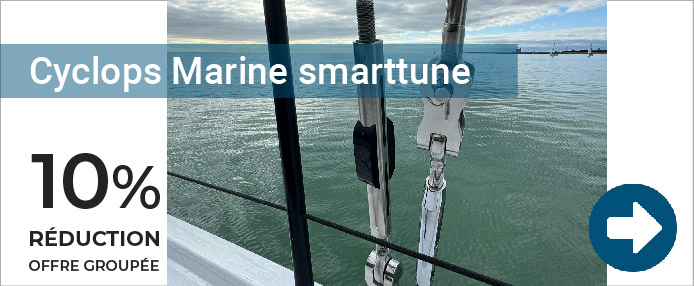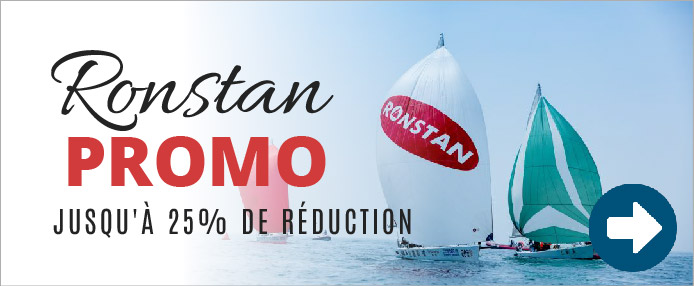Poulies violon
Les poulies de renvoi ont deux réas dans le même plan. Cette configuration permet de maintenir l'ensemble du palan sur le même axe, ce qui limite la torsion. Ces poulies sont utilisées comme un ensemble de quatre lignes et d'un palan double. Notez que le diamètre maximal de la ligne est déterminé par le réa le plus petit. En savoir plus...
-
Général
-
Poulies ouvrantes
-
Anneaux et réas à friction
-
Poulies plat pont
-
Sigles de mâts
-
Poulies de saut de rouf et flip-flop
-
Boîtes à réa
-
Poulies violon
-
Systèmes de palan d'écoutes de grand-voile
-
Poulies de bastaque / de pataras
-
Poulies de drisse
-
Poulies d'écoute et de ris
-
Accessoires pour poulie
-
Poulies de point d'écoute
-
Ratchet bloc
|
|
Fiddle Blocks – Function, Design and Applications
Fiddle blocks are a fundamental component in many of the most effective multi-purchase control systems aboard small to medium-sized sailboats. Their defining feature is the asymmetric double-sheave design, with one large and one smaller sheave mounted vertically within the same frame. This unique form factor provides several mechanical and functional advantages over traditional double blocks, particularly where space, line alignment, and efficient load distribution are critical.
What is a Fiddle Block?
A fiddle block is a two-sheave block where the sheaves are arranged in tandem, rather than side-by-side as in a standard double block. The primary (larger) sheave usually handles the main load-bearing part of the line, while the secondary (smaller) sheave manages the returning line in a tackle system. This configuration reduces line crossover, helps manage friction under higher loads, and supports a cleaner and more compact rope path.
Depending on the model, fiddle blocks may include:
- Beckets for terminating control lines,
- Swivel heads to allow rotation under load,
- Integrated cam cleats for one-handed trimming and locking,
- Ratchet functionality (on some smaller formats) for enhanced grip in manual systems.
Fiddle Block Key Performance Features
Mechanical Advantage and Purchase Ratios
Fiddle blocks are optimised for systems where a high purchase ratio is required within a constrained layout. When used in a traditional block-and-tackle, they can form the basis of 4:1, 6:1 or even 8:1 systems. For example:
- A single fiddle block with becket paired with a double block on the other end creates a simple, powerful 4:1 system.
- Adding a second fiddle block or cascading system increases purchase without excessive friction or rope length.
- This makes them ideal in applications where crew strength is limited, but precise trimming is still essential.
Compactness and Rope Routing
By vertically stacking the sheaves, fiddle blocks maintain a narrow footprint, which is especially useful when space is limited or the rope entry/exit angles are fixed (e.g., cockpit floors, spars). The vertical orientation naturally separates rope paths, reducing the chance of twist, friction, or overlap. The result is cleaner rope handling and more efficient load transfer.
Load Distribution and Sheave Size
The different sheave diameters in a fiddle block are not arbitrary. The larger sheave handles dynamic load more efficiently, improving line longevity and reducing internal heat/friction. The smaller sheave supports the return line or slack segment, minimising overall system bulk. This balance supports sustained high-load use, particularly in high-cyclic applications such as mainsheet or vang systems.
Applications of Fiddle Blocks
Fiddle blocks are found across a wide range of control systems, particularly where high purchase and clean rope handling are required. Typical applications include:
Mainsheet Systems
- Fiddle blocks are frequently used in mainsheet systems for dinghies, sportboats, and small keelboats.
- A fiddle block with becket and cleat can serve as the trimming point in cockpit-floor or boom-mounted systems, offering compact high-purchase control.
- Paired with a boom block or traveller block, they enable highly effective 4:1 or 6:1 configurations.

| DiagramRef. | Description | Small Boat Part No. | Midrange Part No. | Big Boat Part No. |
| A | Fiddle | 2621 | 2690 | 1559 |
| B | Fiddle | 2676 | 2697 | 1566 |
Harken 4:1 Fiddle Mainsheet Systems Setup
Boom Vangs (Kickers)
- The vang (or kicker) system often requires high mechanical advantage to control leech tension and prevent mainsail twist.
- Fiddle blocks are ideal for 4:1 or 6:1 vang systems, especially with a cleating function or cascade integration.
- They allow vertical or angular lead-in/out, important for complex vang geometries.

| DiagramRef. | Description | Small Boat Part No. | Midrange Part No. | Big Boat Part No. |
| A | Single | 300 | 304 | 308 |
| B | Fiddle | 2655 | 2621 | 1559 |
| C | Fiddle | 2658 | 2624 | 1564 |
Harken 8:1 Cascaded Fiddle Boom Vang Systems Setup
Backstay Tensioners
- On small keelboats with split or rope backstays, fiddle blocks can be used in the tensioning cascade to increase mechanical advantage in a tight space.
- A fiddle block and becket block in series can form an effective 6:1 or 8:1 cascade.
Traveller and Adjuster Systems
- Though less common than for mainsheets, fiddle blocks may be used in traveller car control lines, especially where control lines need to be led back to the helm and purchase must be increased without additional sheaves.
- Their narrow profile makes them easy to integrate into side-deck or cabin-top installations.
Fiddle Block Construction and Material Options
Most modern fiddle blocks are built from composite, anodised aluminium or stainless steel side plates with sheaves made from either high-load composite (Delrin, Acetal) or anodised alloy. Key considerations include:
- Bearing Type: Ball-bearing sheaves (e.g., Harken Carbo, Ronstan Orbit) offer low friction under light loads; plain-bearing blocks provide better performance under extreme static loads.
- Attachment Style: Swivel heads, fixed eyes, soft-attach options (Dyneema® loops), or snap shackles are available depending on layout needs.
- Cleating Function: Many fiddle blocks include integrated cam cleats, typically on the trimmer’s side for ergonomic access.
Leading manufacturers—Harken, Ronstan, Antal, Selden, and Viadana—offer a broad range of fiddle block options, including:
- Harken Carbo and Element Fiddle Blocks (lightweight, high-load),
- Ronstan Orbit Fiddle Blocks (soft-attach and cleating options),
- Antal V-Grip and standard series (high-performance aluminium),
- Selden BB fiddle block (durable cruising solutions).
Sizing Guidelines
When selecting a fiddle block, match the block’s working load and rope diameter range with your expected system load and control line spec. As a general guide:
Application | Rope Ø | Typical Sheave Size | Purchase Ratio |
Dinghy mainsheet | 6–8mm | 40–55mm | 3:1 to 6:1 |
Sportboat vang | 8–10mm | 55–70mm | 4:1 to 8:1 |
Keelboat mainsheet | 10–12mm | 60–75mm | 4:1 to 6:1 |
Summary on Fiddle Blocks
Fiddle blocks are a compact, efficient solution for high-purchase systems where precise sail or rig trim is essential. Their stacked sheave layout enables clean line management and reduced friction without increasing system size. Whether you're rigging a new mainsheet, vang, or backstay tensioner, Upffront provides a full range of fiddle blocks from the industry's most respected brands—ensuring you get the performance, durability, and reliability demanded by serious sailors.

To install this Web App in your iPhone/iPad press
![]() and then Add to Home Screen.
and then Add to Home Screen.



